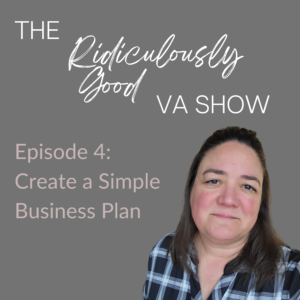Today’s Quote: Failing to plan is planning to fail – Benjamin Franklin
Welcome to another episode of the podcast that teaches you how to be a ridiculously good virtual assistant.
In this episode, we will talk about creating a simple business plan.
It may sound daunting but it really helps you get organized with what you want your VA business to be.
Click the play button above to tune in, or choose your favourite podcast player below:


Connect with Tracey D’Aviero, VA Coach and Trainer




Episode Notes:
Do you really need a business plan for your Virtual Assistant business?
Short answer, yes.
To succeed in your business, you have to have a plan.
And it starts with a business plan
I teach a Virtual Assistants to create a simple business plan – one that contains only what you need to get your business off the ground – essentially it is used to make sure that you have made all the decisions necessary to put a solid foundation under your business.
Here are the components of a VA business plan that I’ll talk about today:
Executive Summary
Business Model
Finance/Revenue Forecasting
Services and Rates
Clients
Competitive Analysis
Marketing Plan
Business Model
A business model helps you design your business. How will you earn money or charge your clients?
Will you charge hourly?
Will you have your clients pay by prepaid retainer where you tick off time or tasks?
Will you operate a team, or work with subcontractors?
Will you take on part-time work while you get your business started? Or will you start your business full-time?
Will you work on a commission basis?
There are a lot of ways that you can decide to ‘get paid’. The business model helps you make all of these decisions. And it also helps you to forecast revenue as you make changes if you are moving from a corporate job to a full time contractor.
Speaking of revenue forecasting, it’s important to then think about how much each of your clients will pay you – that determines how many clients you will need to work with to earn the money you need to meet your goals.
Services and Rates
Choosing your services and setting your rates go hand in hand. Your experience with the services you will offer your clients plays a part of what you will charge. You also need to do the math for what your business needs to bring in to run at a profit.
Your revenue levels will dictate what you will offer and how much to charge. When you know how much you need to bring in each month, you can create packages or levels of services for your clients, and fit your services into those accordingly.
That doesn’t necessary mean packages, you can still charge by the hour, but you do need to work it all out based on what you need to bring in every month.
Clients
Next you need to decide who you will work with. It can be a target market or industry or location, whatever makes sense for you.
But you must plan to target a large group of people in order to find any level of success quickly.
Tailoring your service offerings to a specific group of business owners is the fastest way to fill your client list.
Competitive Analysis
Checking out your competition means more than just seeing what they charge. It’s a great way to get an idea of what you might want to model, though.
Look at how the present their service offerings, who they connect with, who they support. This is the kind of information you want to collect for the competitive analysis portion of your business plan. Research is your friend here. Decide what you need to know about them and research it.
Marketing
The final part of your plan is where will you find clients. Where will you promote your business?
When you know who you need to target, you have to find out where they are congregating online, offline and wherever else they are. Once you know where they are you have to figure out what you will say to them when you find them and start networking with them.
How many people do you need to connect with so you can sign clients. That’s marketing!
Executive Summary
Now pull it all together and you have your business plan. The Executive Summary is the place to tie it all together and summarize each section. If you can do this easily, you have compiled the right information.
Your business plan helps you to answer a lot of questions that you need to answer to set your business. It’s okay to not know the answers to these questions, but you do need to make some decisions and do a little math.
As you go through each section, find the answers. Once you do, it’s time to get going!
Once you finish your business plan, consult it often. Update it regularly. Use it to build your business – it’s not meant to be a one and done thing.
What You Need to Do Next:
If I can help you build your business plan (or answer any of the questions you don’t have the answers to right now), reach out to me at tracey@yourvamentor.com. I’ve helped hundreds of VAs through their challenges and got them on their way to the next thing. I’d love to do the same for you. I do private coaching, and registration for my new mastermind group The Virtual Circle is open now. Maybe one of those is right for you!
That’s all I’ve got for you this week, thanks for tuning in to learn to become a ridiculously good Virtual Assistant.